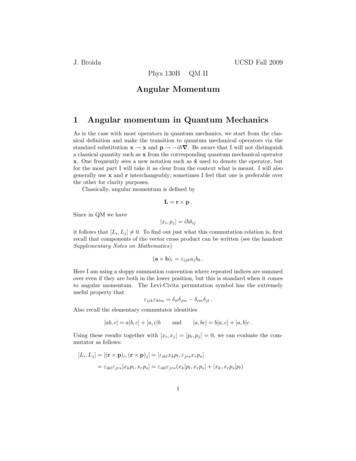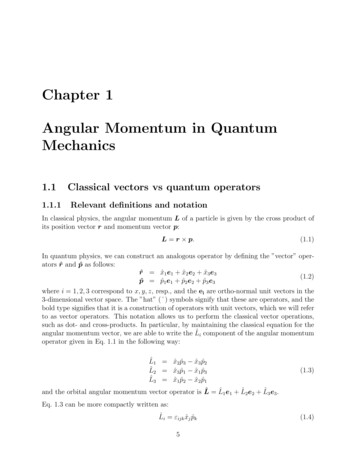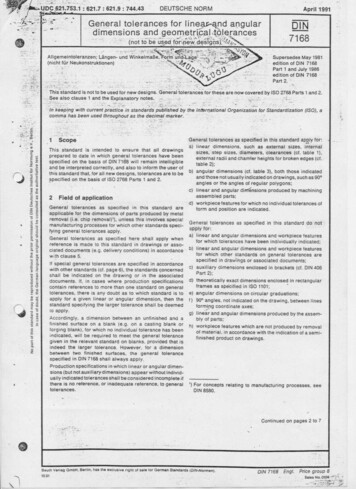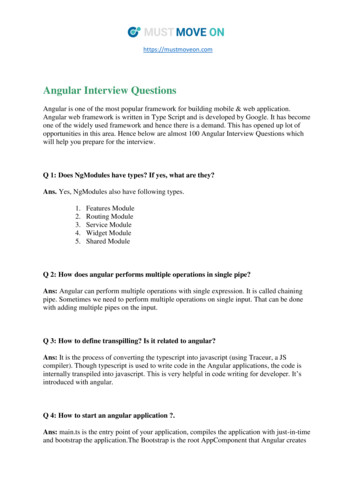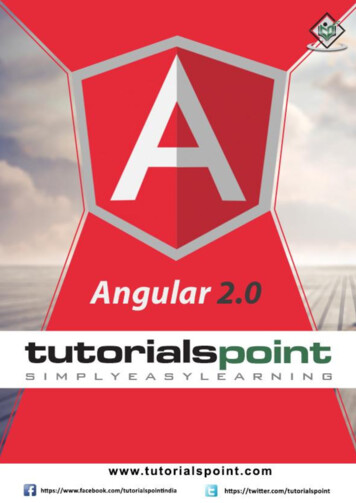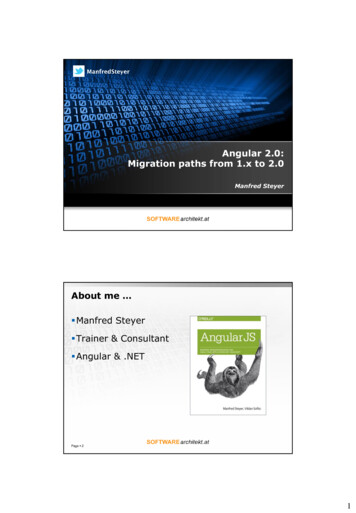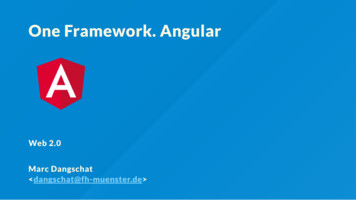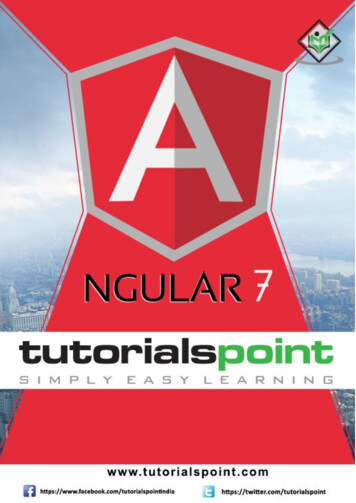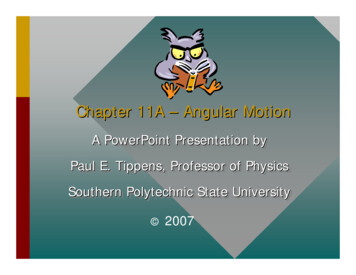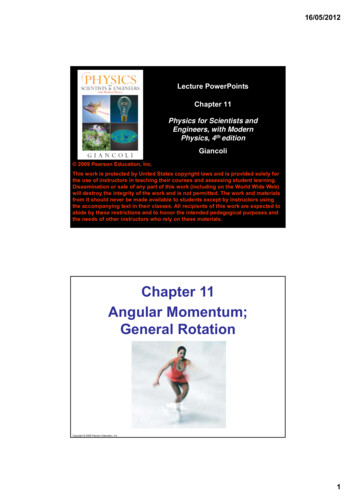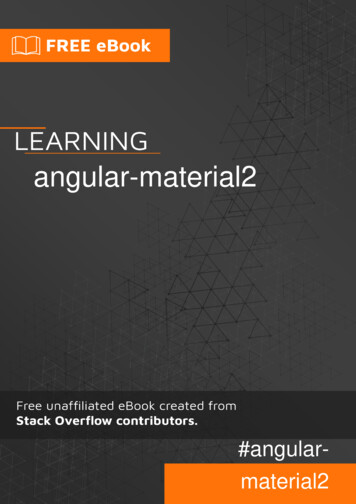
Transcription
angular-material2#angularmaterial2
Table of ContentsAbout1Chapter 1: Getting started with lation or Setup with Angular CLI2Wrapping all modules together3Installation and Setup from master with Angular CLI4Set up theme, gesture support and material icons5Chapter 2: rate control and display7Get md-autocomplete's options/searchable data from API8Utilize md-autocomplete inside a reactive form10One md-autocomplete for multiple formControl13Chapter 3: ples16Simple buttonsChapter 4: Data binding with md-datapicker17Passing selected date value to a function using event17Open datepicker on focus18
Set different locale for md-datepickerChapter 5: ialize md-dialog with data passed from parent componentChapter 6: md-iconExamples222424Creating an icon24Using SVG Icons24Chapter 7: md-table26Introduction26Remarks26Examples26Connect DataSource from external APICredits2629
AboutYou can share this PDF with anyone you feel could benefit from it, downloaded the latest versionfrom: angular-material2It is an unofficial and free angular-material2 ebook created for educational purposes. All thecontent is extracted from Stack Overflow Documentation, which is written by many hardworkingindividuals at Stack Overflow. It is neither affiliated with Stack Overflow nor official angularmaterial2.The content is released under Creative Commons BY-SA, and the list of contributors to eachchapter are provided in the credits section at the end of this book. Images may be copyright oftheir respective owners unless otherwise specified. All trademarks and registered trademarks arethe property of their respective company owners.Use the content presented in this book at your own risk; it is not guaranteed to be correct noraccurate, please send your feedback and corrections to info@zzzprojects.comhttps://riptutorial.com/1
Chapter 1: Getting started with angularmaterial2RemarksThis section provides an overview of what angular-material2 is, and why a developer might want touse it.It should also mention any large subjects within angular-material2, and link out to the relatedtopics. Since the Documentation for angular-material2 is new, you may need to create initialversions of those related eta.0Link2016-12-22ExamplesInstallation or Setup with Angular CLIIn this example, we will be using @angular/cli (latest) and the latest version of @angular/material.You should at least know the basics of Angular 2/4 before continuing the steps below.1. Install angular material module from npm:npm install @angular/material --savehttps://riptutorial.com/2
2.0.0-beta.3This only applies to versions 2.0.0-beta.3 and up.Install the @angular/animations module:npm install @angular/animations --save2.0.0-beta.8This only applies to versions 2.0.0-beta.8 and up.Install the @angular/cdk module:npm install @angular/cdk --save2. In your application module import the components which you are going to use:importimportimportimport{{{{NgModule } from '@angular/core';CommonModule } from '@angular/common';RouterModule } from '@angular/router';MdButtonModule, MdSnackBarModule, MdSidenavModule } from '@angular/material';import { AppComponent } from './app.component';import { BrowserAnimationsModule } from imports: Module,MdSidenavModule,CommonModule,// This is optional unless you want to have routing in your app// RouterModule.forRoot([//{ path: '', component: HomeView, pathMatch: 'full'}// ])],declarations: [ AppComponent ],boostrap: [ AppComponent ]})export class AppModule {}You are now ready to use Angular Material in your components!Note: The docs for specific components will be coming soon.Wrapping all modules togetherYou can also easily wrap all angular modules, which you are going to use, into one module:import { NgModule } from '@angular/core';import { MdButtonModule, MdSnackBarModule, MdSidenavModule } from '@angular/material';https://riptutorial.com/3
@NgModule({imports: Module,MdSidenavModule],exports: )export class MaterialWrapperModule {}After that simply import your module into the application main module:import { NgModule } from '@angular/core';import { CommonModule } from '@angular/common';import { RouterModule } from '@angular/router';import { MaterialWrapperModule } from './material-wrapper.module.ts';import { AppComponent } from './app.component';@NgModule({imports: monModule,// This is optional, use it when you would like routing in your app// RouterModule.forRoot([//{ path: '', component: HomeView, pathMatch: 'full'}// ])],declarations: [ AppComponent],bootstrap: [ AppComponent ]})export class AppModule {}Installation and Setup from master with Angular CLIThis example will be how to install from master and will be using @angular/cli as well.1. Make a new project with @angular/cli:ng new my-master-appIf you haven't installed @angular/cli, use this command:npm install -g @angular/cli2. Install from master:https://riptutorial.com/4
npm install --save @angular/animationsnpm install --save angular/material2-buildsnpm install --save angular/cdk-builds3. Follow the same guide as above.Done!Set up theme, gesture support and material iconsTheme:A theme is required for material components to work properly within the application.Angular Material 2 provides four prebuilt themes: enIf you are using Angular CLI, you can import one of the prebuilt themes in style.css.@import " ;Theme can be added using link in index.html as well. link href "node ink.css" rel "stylesheet" HammerJSAdd HammerJS to the application via CDN or npm:npm install --save hammerjsIn your root module, usually app.module.ts, add the import statement:import 'hammerjs';Material Icons:Unless, custom icons provided, Angular Material 2 md-icon expects Material Icons.In index.html add: link href "https://fonts.googleapis.com/icon?family Material Icons" rel "stylesheet" https://riptutorial.com/5
Read Getting started with angular-material2 online: iptutorial.com/6
Chapter 2: md-autocompleteIntroductionThis topic includes coding examples related to Angular Material 2 Autocomplete (mdautocomplete)RemarksThese examples don't cover all features of md-autocomplete. Please read the documentationlearn more about md-autocomplete.ExamplesSeparate control and displayThis example shows how to to display specific property in dropdown but bind with the wholeobject.autocomplete-overview-example.html: md-input-container input mdInput placeholder "State" [(ngModel)] "selection"[mdAutocomplete] "auto" [formControl] "stateCtrl" /md-input-container md-autocomplete #auto "mdAutocomplete" [displayWith] "displayFn" md-option *ngFor "let state of filteredStates async" [value] "state" {{ state.Country }} /md-option /md-autocomplete p Selected Country: {{selection json}} /p p Selected Country Id: {{selection?.CountryID}} /p autocomplete-overview-example.ts:import {Component} from '@angular/core';import {FormControl} from '@angular/forms';import 'rxjs/add/operator/startWith';import 'rxjs/add/operator/map';@Component({selector: 'autocomplete-overview-example',templateUrl: 'autocomplete-overview-example.html',})export class AutocompleteOverviewExample {stateCtrl: FormControl;https://riptutorial.com/7
filteredStates: any;selection: any;states [{ Country: "United States Of America" , CountryID: "1"},{ Country: "United Kingdom" , CountryID: "2"},{ Country: "United Arab Emirates" , CountryID: "3"},];constructor() {this.stateCtrl new FormControl();this.filteredStates untry country && typeof country 'object' ? country.Country : country).map(name this.filterStates(name));}filterStates(val) {return val ? this.states.filter(s s.Country.toLowerCase().indexOf(val.toLowerCase()) 0): this.states;}displayFn(country): string {console.log(country);return country ? country.Country : country;}}Live ExampleGet md-autocomplete's options/searchable data from APIdata.service.ts:import { Injectable } from '@angular/core';import { Http } from '@angular/http';import 'rxjs/add/operator/map';@Injectable()export class DataService {constructor(private http: Http) { }fetchData(){return com/.json').map((res) res.json())}}autocomplete-overview-example.html: md-input-container https://riptutorial.com/8
input mdInput placeholder "Name" [mdAutocomplete] "auto" [formControl] "stateCtrl" /md-input-container md-autocomplete #auto "mdAutocomplete" [displayWith] "displayFn" md-option *ngFor "let sector of filteredSectors async" [value] "sector" {{ sector.name }} /md-option /md-autocomplete div h2 Data : /h2 span {{ allSectors json /div }} /span autocomplete-overview-example.ts:import {Component, OnInit} from '@angular/core';import {FormControl} from '@angular/forms';import { DataService } from './data.service';import 'rxjs/add/operator/startWith';import 'rxjs/add/operator/map';@Component({selector: 'autocomplete-overview-example',templateUrl: './autocomplete-overview-example.html',})export class AutocompleteOverviewExample implements OnInit{stateCtrl: FormControl;filteredSectors: any;allSectors;constructor(private dataService: DataService) {this.stateCtrl new ta().subscribe((data) {this.allSectors data.customers;this.filteredSectors l val ? this.filter(val) : this.allSectors.slice());});}filter(name) {return this.allSectors.filter(sector new RegExp( {name} , 'gi').test(sector.name));}displayFn(sector) {return sector ? sector.name : sector;}}https://riptutorial.com/9
Live ExampleUtilize md-autocomplete inside a reactive formThis example requires FormsModule and ReactiveFormsModule. Please import them in yourapplication/module.import {FormsModule, ReactiveFormsModule} from '@angular/forms';input-form-example.html form class "example-form" (ngSubmit) "submit(addForm.value)" [formGroup] "addForm" md-input-container class "example-full-width" input mdInput placeholder "Company (disabled)" disabled value "Google"formControlName "company" /md-input-container table class "example-full-width" cellspacing "0" tr td md-input-container class "example-full-width" input mdInput placeholder "First name" formControlName "fname" /md-input-container /td td md-input-container class "example-full-width" input mdInput placeholder "Long Last Name That Will Be Truncated" /md-input-container /td /tr /table p md-input-container class "example-full-width" textarea mdInput placeholder "Address" formControlName "address" 1600 AmphitheatrePkwy /textarea /md-input-container md-input-container class "example-full-width" textarea mdInput placeholder "Address 2" /textarea /md-input-container /p table class "example-full-width" cellspacing "0" tr td md-input-container class "example-full-width" input mdInput placeholder "City" formControlName "city" /md-input-container /td td md-input-container input mdInput placeholder "State"[mdAutocomplete] "auto"[formControl] "stateCtrl"formControlName "state" /md-input-container /td td md-input-container class "example-full-width" input mdInput #postalCode maxlength "5" placeholder "Postal Code" value "94043"formControlName "zip" md-hint align "end" {{postalCode.value.length}} / 5 /md-hint /md-input-container /td /tr /table button md-raised-buttontype "submit" Submit /button md-autocomplete #auto "mdAutocomplete" https://riptutorial.com/10
md-option *ngFor "let state of filteredStates async" [value] "state"(onSelectionChange) "selectState(state, addForm.value)" {{ state }} /md-option /md-autocomplete /form p Form values: /p p {{ addForm.value json }} /p ponent} from '@angular/core';{FormBuilder, FormGroup, FormControl} from js/add/operator/map';@Component({selector: 'input-form-example',templateUrl: 'input-form-example.html',styleUrls: ['input-form-example.css'],})export class InputFormExample {stateCtrl: FormControl;filteredStates: any;addForm: FormGroup;state;states https://riptutorial.com/11
'New Hampshire','New Jersey','New Mexico','New York','North Carolina','North 'Rhode Island','South Carolina','South inia','Washington','West ate fb: FormBuilder) {this.addForm this.fb.group({fname: '',address: '',address2: '',city: '',"state": this.state,zip: '',company: '',lname: ''});this.stateCtrl new FormControl();this.filteredStates me th
2.0.0-beta.3 Link 2017-04-07 2.0.0-beta.2 Link 2017-02-15 2.0.0-beta.1 Link 2016-12-23 2.0.0-beta.0 Link 2016-12-22 Examples Installation or Setup with Angular CLI In this example, we will be using @angular/cli (latest) and the latest version of @angular/material. You should at least know the basics of Angular 2/4 before continuing the steps below.
